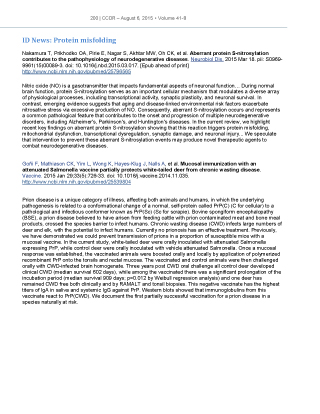ID News: August 2015

 Download this article as a PDF (263 KB - 1 page)
Download this article as a PDF (263 KB - 1 page) Published by: The Public Health Agency of Canada
Issue: Volume 41-8: Protein misfolding disorders
Date published: August 6, 2015
ISSN: 1481-8531
Submit a manuscript
About CCDR
Browse
Volume 41-8, August 6, 2015: Protein misfolding disorders
ID News
Protein misfolding
Nakamura T, Prikhodko OA, Pirie E, Nagar S, Akhtar MW, Oh CK, et al. Aberrant protein S-nitrosylation contributes to the pathophysiology of neurodegenerative diseases. Neurobiol Dis. 2015 Mar 18. pii: S0969-9961(15)00089-3. doi: 10.1016/j.nbd.2015.03.017. [Epub ahead of print]
Nitric oxide (NO) is a gasotransmitter that impacts fundamental aspects of neuronal function… During normal brain function, protein S-nitrosylation serves as an important cellular mechanism that modulates a diverse array of physiological processes, including transcriptional activity, synaptic plasticity, and neuronal survival. In contrast, emerging evidence suggests that aging and disease-linked environmental risk factors exacerbate nitrosative stress via excessive production of NO. Consequently, aberrant S-nitrosylation occurs and represents a common pathological feature that contributes to the onset and progression of multiple neurodegenerative disorders, including Alzheimer's, Parkinson's, and Huntington's diseases. In the current review, we highlight recent key findings on aberrant protein S-nitrosylation showing that this reaction triggers protein misfolding, mitochondrial dysfunction, transcriptional dysregulation, synaptic damage, and neuronal injury... We speculate that intervention to prevent these aberrant S-nitrosylation events may produce novel therapeutic agents to combat neurodegenerative diseases.
Goñi F, Mathiason CK, Yim L, Wong K, Hayes-Klug J, Nalls A, et al. Mucosal immunization with an attenuated Salmonella vaccine partially protects white-tailed deer from chronic wasting disease. Vaccine. 2015 Jan 29;33(5):726-33. doi: 10.1016/j.vaccine.2014.11.035.
Prion disease is a unique category of illness, affecting both animals and humans, in which the underlying pathogenesis is related to a conformational change of a normal, self-protein called PrP(C) (C for cellular) to a pathological and infectious conformer known as PrP(Sc) (Sc for scrapie). Bovine spongiform encephalopathy (BSE), a prion disease believed to have arisen from feeding cattle with prion contaminated meat and bone meal products, crossed the species barrier to infect humans. Chronic wasting disease (CWD) infects large numbers of deer and elk, with the potential to infect humans. Currently no prionosis has an effective treatment. Previously, we have demonstrated we could prevent transmission of prions in a proportion of susceptible mice with a mucosal vaccine. In the current study, white-tailed deer were orally inoculated with attenuated Salmonella expressing PrP, while control deer were orally inoculated with vehicle attenuated Salmonella. Once a mucosal response was established, the vaccinated animals were boosted orally and locally by application of polymerized recombinant PrP onto the tonsils and rectal mucosa. The vaccinated and control animals were then challenged orally with CWD-infected brain homogenate. Three years post CWD oral challenge all control deer developed clinical CWD (median survival 602 days), while among the vaccinated there was a significant prolongation of the incubation period (median survival 909 days; p=0.012 by Weibull regression analysis) and one deer has remained CWD free both clinically and by RAMALT and tonsil biopsies. This negative vaccinate has the highest titers of IgA in saliva and systemic IgG against PrP. Western blots showed that immunoglobulins from this vaccinate react to PrP(CWD). We document the first partially successful vaccination for a prion disease in a species naturally at risk.
Page details
- Date modified: